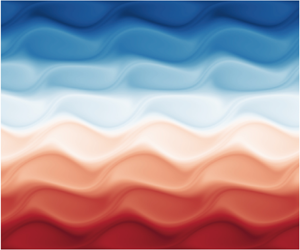No CrossRef data available.
Article contents
Double diffusive convection in the diffusive regime with a uniform background shear
Published online by Cambridge University Press: 13 September 2024
Abstract

This study proposes a new mechanism that can lead to layering or convection from the finite amplitude perturbation acting on the double diffusive convection with uniform background shear. We focus on the double diffusive convection in the diffusive regime with the cold fresh water laying above the warm salty water. We demonstrate that, although the unperturbed system is linearly stable, the finite amplitude perturbation can trigger the initial flow motions which subsequently obtain energy from the gravitational potential energy and from the uniform background shear, and evolve to layering or convection. By using the linear stability analysis for the initial growth stage and the energy analysis for the following transitional stage, the critical Richardson number can be predicted theoretically. Here the Richardson number measures the relative strength of stratification to the background shear. The dominant wavenumbers and the growth rates of the corresponding modes given by linear theory agree well with the two-dimensional direct numerical simulations, and so does the critical Richardson number predicted by the theoretical model. The layering state is dominated by the double diffusion process, while the convection state at smaller Richardson number exhibits stronger influences from shear and generates smaller heat and salinity fluxes. The theoretical model is further applied to the parameter range which is relevant to the real oceanic environments and reveals that for the typical density ratio observed in the staircase regions in the Arctic Ocean, the current mechanism can lead to layering for relatively weak shear.
- Type
- JFM Papers
- Information
- Copyright
- © The Author(s), 2024. Published by Cambridge University Press



